Are you considering a National Park trip in the near future? Are you struggling to decide which park to visit? If so, that is completely understandable! From Joshua Tree National Park in southern California to Glacier National Park in Montana, the United States has some of the most incredible and beautiful natural landscapes.
These parks attract millions of visitors each year, and for good reason. Deciding which National Park should be next on your list to visit can be difficult. To make your decision a little bit easier, this article provides 15 reasons why Utah‘s Zion National Park is one of the most amazing parks in the country – and the one you should go to next.
Let’s jump in!
About Zion National Park
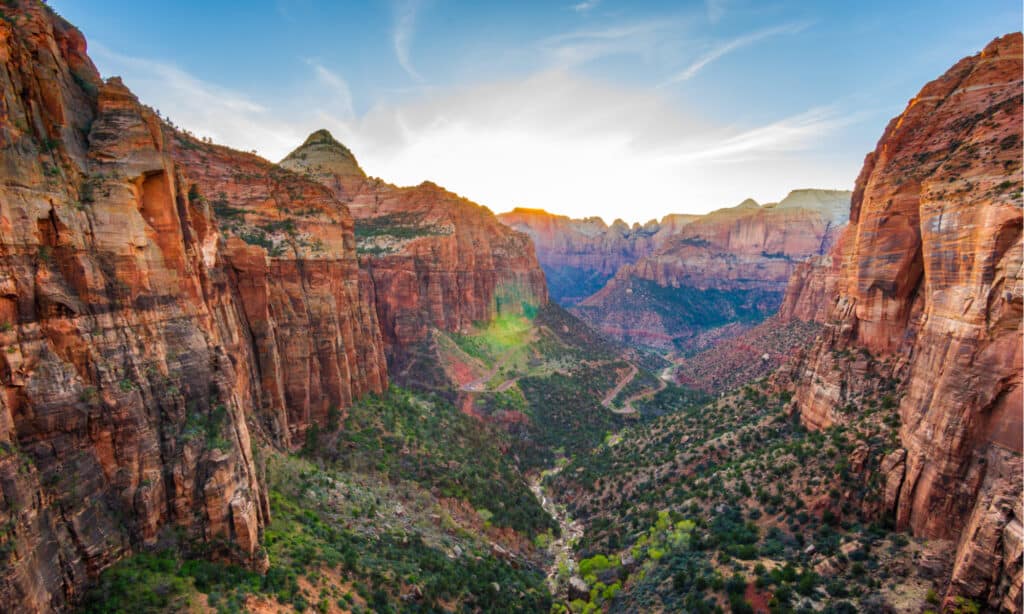
Zion National Park is known for its sandstone walls with dramatic cliffs.
©Asif Islam/Shutterstock.com
Zion National Park is a national park located in southern Utah in the western United States. As one of Utah’s five national parks, Zion is the place to see incredible geological formations, enjoy scenic vistas, hike challenging trails, climb big walls, and see wildlife and plant life in a natural setting. Zion is also one of the most popular national park destinations in the country and attracts over 5 million visitors each year. One of the primary purposes of Zion National Park is to protect the natural landscapes, plants, animals, and history, and give people the opportunity to learn about these things.
The most prominent feature in the park is Zion Canyon, and other important features include the Crawford and Kolob arches among others throughout the park. With miles of trails, incredible cliffs, slot canyons, cascading waterfalls, gorgeous gardens, desert plateau grasslands, and clear rivers, Zion is known for having some of the best hiking, biking, camping, and climbing. It’s certainly a destination for outdoor adventure and recreation. However, whatever your passion or outdoor experience, Zion has something for you.
Zion National Park encompasses 232 square miles of scenic canyon country across Utah’s Washington, Iron, and Kane Counties.
1. Zion Has Some of the Most Incredible Hiking Trails

Angel’s Landing is just one of the popular hiking trails in Zion National Park.
©Flystock/Shutterstock.com
When it comes to hiking, Zion National Park has some of the most scenic, challenging, and rewarding trails of all National Parks in the U.S. The most popular trails in Zion National Park are in Zion Canyon. Zion Canyon has hikes for all levels of exertion or technical hiking skill – so whatever your ability and interest, there is probably a beautiful hike that will interest you.
However, two of the famous hikes in Zion Canyon are Angels Landing and The Narrows. But be careful! These are two of the most strenuous hikes in Zion National Park and are not suitable for young children or anyone unable or unwilling to hike for hours on end. Angels Landing, for example, takes approximately 4 hours to cover 5.4 miles and cross a steep, narrow ridge. This is not the route for hikers who are afraid of heights! It is also important to note that a section of the hike to Angels Landing does require a permit. Learn more about Angels Landing permits and hiking routes on the National Park Service website!
The Narrows, on the other hand, require hikers to wade and sometimes even swim through cold, fast-flowing water. In fact, about 60% of the hike is through a river!
Before hiking in Zion, be sure to do your research in advance, bring the right gear, and check that you have your route planned out ahead of time. You should also check the weather forecast and consult the National Parks website to ensure there are no warnings or imminent weather to be aware of.
2. Zion Has Ancient, Iconic Rock Formations
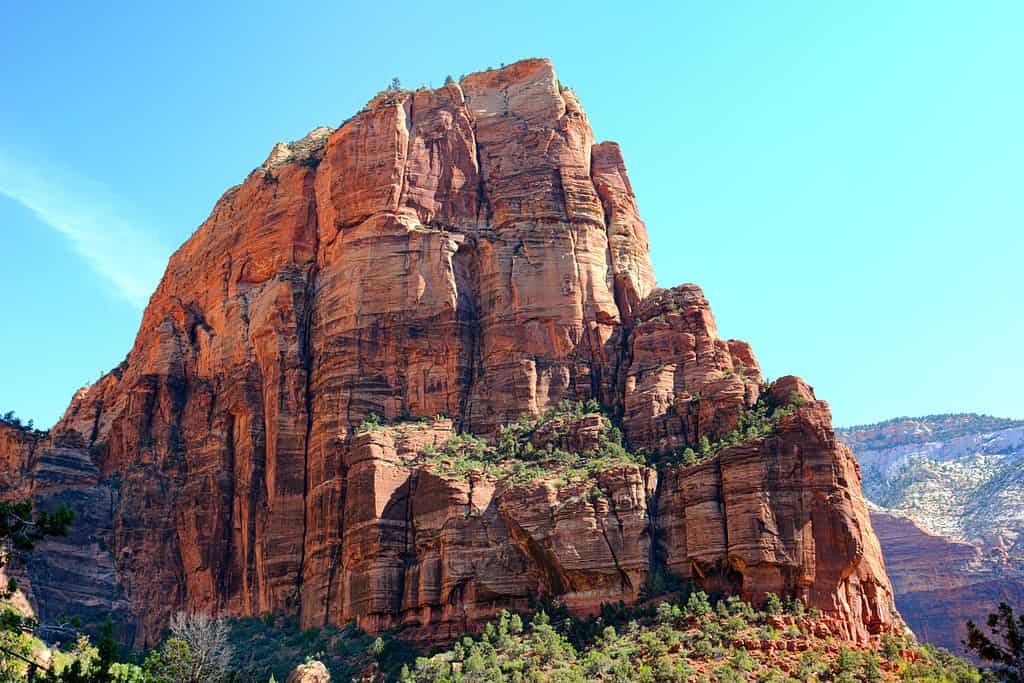
Angels Landing is located in Zion National Park and demonstrates the park’s incredible layered sedimentary rock.
©Steve Cukrov/Shutterstock.com
Hiking Zion National Park’s trails is just one way to experience the wonders of the park’s natural landscape. Even driving through the park, you will get to see dramatic sandstone cliffs, natural arches, and beautiful mountains. Most of the oldest rocks found here are sedimentary rocks. That means that they are formed from bits and pieces of older rocks. As these older rocks eroded, they were deposited in layered formations. Hidden in each of these rock layers is evidence of life in an ancient ecosystem. The rock layers in Zion today were deposited millions of years ago.
Zion also has young (in geological terms) volcanic rocks. You can learn all about Zion’s rock layers by visiting the National Park Service’s website.
Most visitors to Zion National Park home to see the park’s famous rock formations, iconic sights like the Tower of the Virgin, The Spearhead, Lady Mountain, The Great White Throne, and others. One of these natural rock formations is the famous Kolob Arch described below.
3. Zion Is Home to the Second-Biggest Natural Arch in the World
Zion is home to one of the biggest arches in the world: Kolob Arch. Kolob Arch is one of the longest arches in the world. It is 287 feet long and 75 feet thick. This makes it just a small bit shorter than the famous Landscape Arch in the nearby Arches National Park. Hikers who want to visit Kolob Arch can go on a strenuous 14-mile round-trip hike. Hikers can choose between two different hiking trails, both of which are about 7 miles just to reach the arch, then an additional 7 miles to hike back. However, check out the National Park Service website for planning your visit – at times the trailhead is temporarily closed.
4. Zion Canyon is Astonishing

Visitors can enjoy the depths of Zion Canyon on The Narrows hiking route in Zion National Park.
©Stephen Moehle/Shutterstock.com
One of the most prominent features of Zion National Park is Zion Canyon. Zion Canyon is 15 miles long and, at its deepest, 2,640 feet deep. This is the most-visited part of the park and has something for everyone: easy, moderate, and difficult hikes. This deep, narrow gorge was carved by the North Fork of the Virgin River. The most narrow section of the canyon is The Narrows, which many visitors traverse each year. The Narrows Gorge has walls 1,000 feet tall. In places, the river is only 20 or 30 feet across. This makes for stunning views for those who hike this trail and make their way through the river’s water as part of the hike.
5. Zion is a Stunning Place to Stargaze
If you live in a city or suburban community, you may not get many chances to catch a glimpse of a clear night sky full of twinkling stars. Since Zion National Park is in a remote part of Utah and far away from major cities, spending the night in Zion or at a location nearby is a great way to see incredible views of the night sky. Zion is a wonderful place to catch a view of the Milky Way Galaxy. However, this does mean that after sunset, the park gets very dark. If you plan to stay in Zion overnight, ensure that you are prepared with your own source of light and stay out of dark roads where cars may not immediately see you. Then check the astronomical viewing forecast to plan your night sky viewing!
6. Zion Has Over 1,000 Plant Species
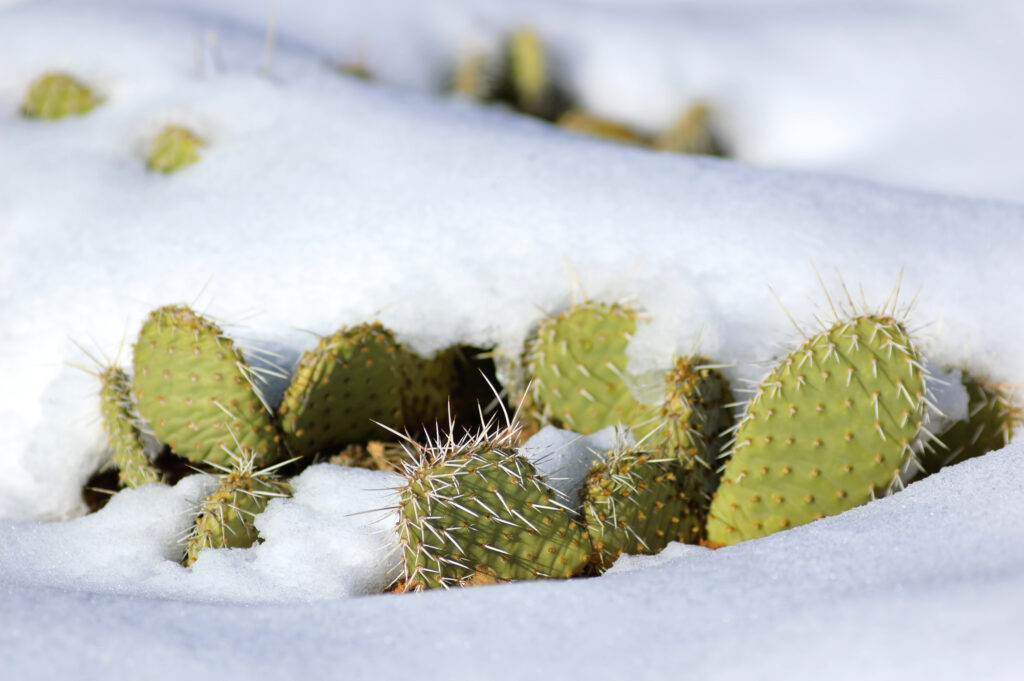
In the winter, you might see cacti covered in snow in Zion National Park.
©Marina Ivanova/Shutterstock.com
Zion is home to over 1,000 species of plants, which live in the park’s varying elevations of 3,700 to 8,700 feet. Because of this diversity in elevation, Zion has an amazing cross-section of plant species. Look out for desert shrubs, the pinyon-juniper forests, ponderosa pines, Douglas fir, white pine, and many other tree and shrub species that appear in different parts of Zion National Park, varying with elevation. The flowers found in Zion include chorispora, columbine, Indian paintbrush, orchid, sand buttercup, sego lily, monkey flowers, and many others.
7. Zion Has Must-Have Souvenirs and a Stellar Visitor’s Center
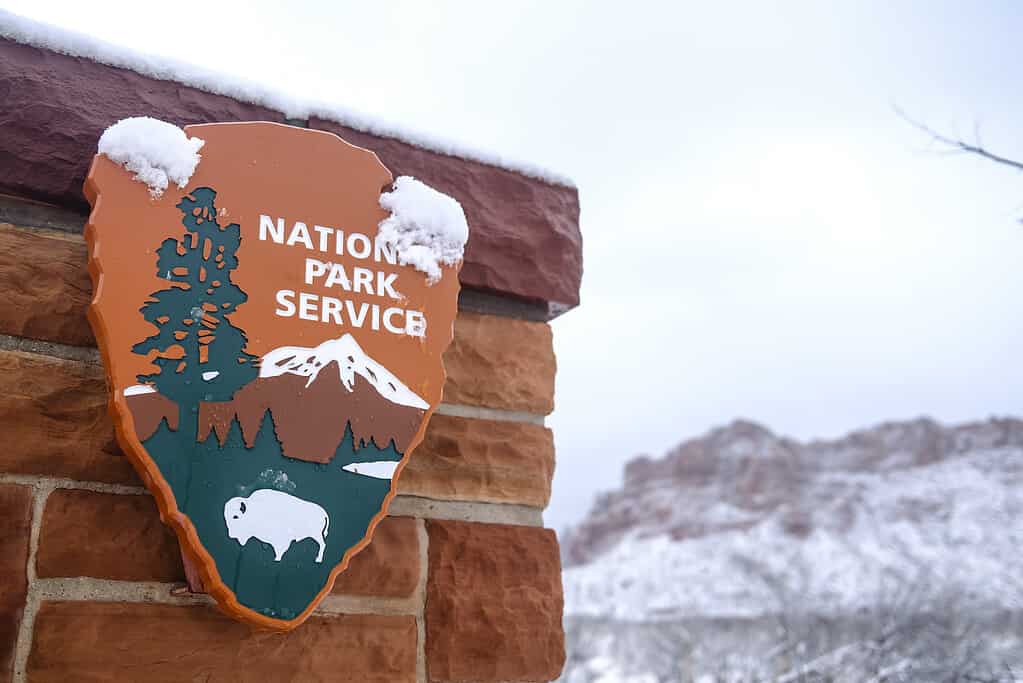
The National Park Service maintains the visitors center at Zion National Park.
©iStock.com/Mike Lewis
If you want to get some guidance on your stay at Zion National Park or simply want to bring home a souvenir, be sure to stop by the fantastic visitors’ center. Zion has expert staff who can help you learn all about the park and guide you to the best gift for your loved one at home.
8. Zion Is Worth Driving Through

The Zion-Mount Carmel Tunnel cuts through the rock in Zion National Park.
©NatalieJean/Shutterstock.com
Some National Parks are really only accessible via hiking. However, some of the awe-inspiring sights of Zion National Park can be experienced with just a drive through the park! For example, visitors can drive the six-mile Zion Canyon Scenic Drive. This road runs north through the heart of the park and takes visitors by car by some of the most incredible rock formations. Then visitors can jump on the Zion-Mt. Carmel Highway, which travels across a gorgeous landscape. When the road is closed to traffic, visitors can still get access to the park by using the park shuttle to experience the wonders of the canyon scenery.
9. Zion Has Jaw-Dropping Desert Waterfalls In and Near the Park

While not inside Zion, Kanarraville Falls in Kanarra Creek Canyon is one of the incredible waterfalls nearby.
©Jeremy Christensen/Shutterstock.com
Have you ever seen a waterfall in the heart of the desert? In Zion National Park, waterfalls fed by winter snowmelt and rainstorms flow down rocks to cold rivers and streams. Some of the most popular waterfalls to visit in Zion are Weeping Rock, the Lower Emerald Pools, Upper Emerald Pools, Pine Creek Falls, and Mystery Canyon Falls in The Narrows. You can also visit other nearby locations outside of the park’s borders to discover other beautiful waterfalls, such as that at Kanarra Creek Canyon in an area outside of Zion National Park.
10. Zion Has Amazing Rock Climbing

Zion National Park offers challenging routes for experienced rock climbers.
©EB Adventure Photography/Shutterstock.com
With its 2,000-foot sandstone cliffs, Zion National Park is renowned around the world for having adventurous big wall climbs. Most of the climbing routes in the park are not recommended for anyone but the most experienced climbers. This is due to their difficulty and the soft rock. Because of this, there are relatively few sport climbing and top roping routes inside Zion itself. However, there are abundant opportunities for climbing just outside of the park itself. As always, it is important for all climbers to practice good climbing practices and follow seasonal climbing guidelines and regulations. Overnight climbs in Zion also require bivy permits, though day climbs do not require permits in advance.
11. Zion Is Heaven for Birdwatchers
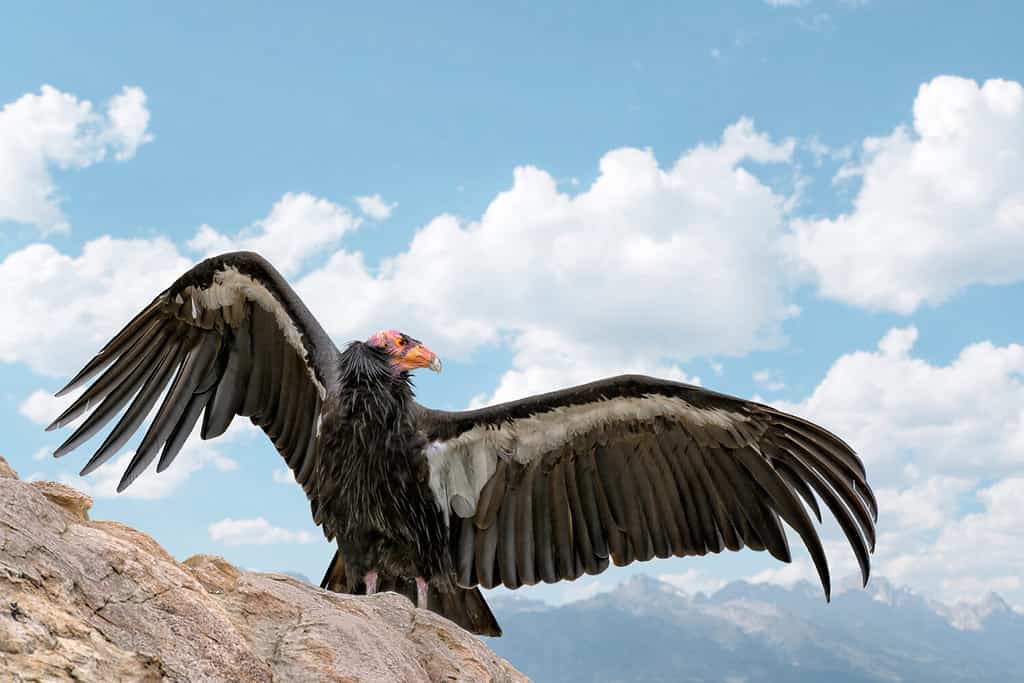
The California condor is just one of the over 290 bird species spotted at Zion National Park.
©Barbara Ash/Shutterstock.com
If you are passionate about tracking feathered friends, Zion National Park will be a fantastic place for you to see a vast array of bird species. There are 291 species that may be seen throughout the park, including species such as the peregrine falcon and the endangered California condor. Bring your binoculars and settle in to see dozens of birds and many mammal species too!
12. Zion Is Home to Diverse Mammal Species

Bighorn sheep
are among the nearly 80 different mammal species found in Zion National Park.
©iStock.com/twildlife
If you are more of a mammal-lover than a birdwatcher, Zion National Park has something to offer you too! In fact, Zion is home to 78 different mammal species. From bighorn sheep to mountain lions, elk, American black bears, coyotes, mule deer, foxes, and rock squirrels, get out your binoculars and keep your eyes open for mammals that you might not see in your daily life outside of Zion.
13. Zion Has Important Archeological Sites
Humans have inhabited the areas now in and around Zion National Park for thousands of years. Most recently, this land was inhabited by Native peoples until they were displaced during American history. However, going back a much longer time period, the land that is now Zion National Park was home to the Archaic, Ancestral Puebloan, Southern Paiute, and other people groups who lived and raised families there.
In order to understand the history of the land and its peoples, Zion National Park has a long history of archeological digs going back over 100 years to 1906. Today, there is still archeological excavation. However, there is an effort to keep archeological sites undisturbed and preserve their original context. Typically, excavation only occurs on sites that are at risk for damage from flooding, erosion, or construction. It is also important that archeologists maintain and manage this land in collaboration with Native tribes.
14. Zion’s National Park Service Rangers Are Rockstars
Zion National Park’s National Park Service rangers are helpful guides for visitors, answering questions, and providing education and learning opportunities. The park’s rangers facilitate over 1.8 million interactions with visitors at the visitor centers, on trails, and on the park shuttles each year. They also lead distance learning with over 8,000 students from across the United States and answer over 26,000 phone calls and emails every year! These park rangers do a great job sharing information about visiting Zion and teaching visitors and students about the park.
15. Zion is a Photographer’s Paradise
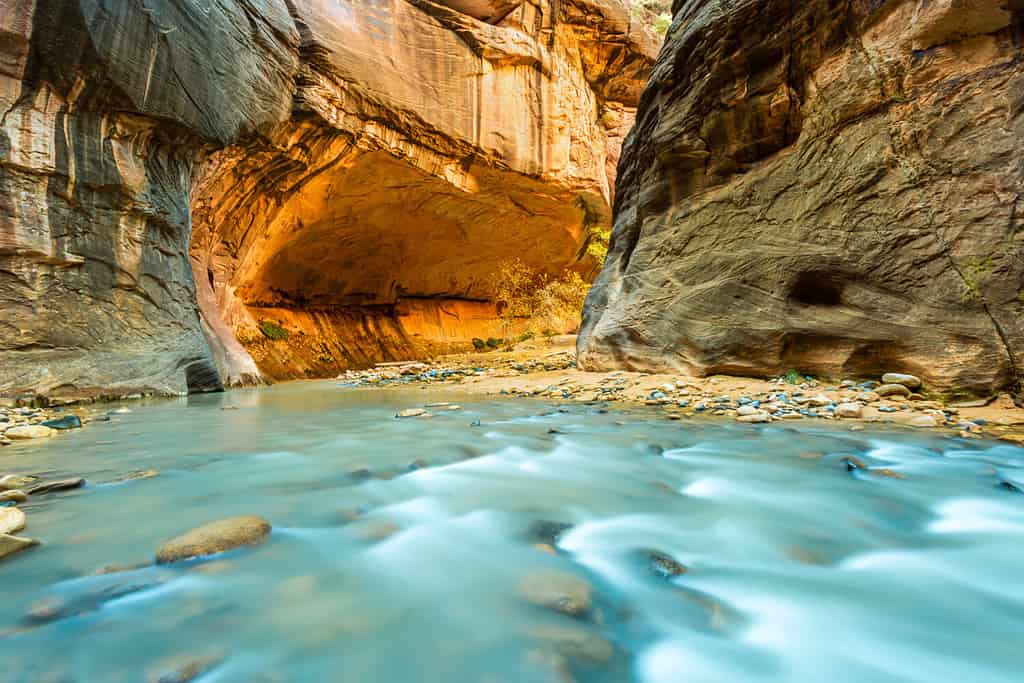
Photographers in Zion National Park capture stunning images of the natural landscape.
©Wildvet/Shutterstock.com
Whether you visit Zion as a tourist or professional, the park’s vibrant-colored sandstone layers in shades of pink, red, and orange are a photographer’s dream! The stunning backdrop is the perfect place to capture family portraits, document a hiking or camping adventure, film a proposal or special moment, or simply bask in the natural beauty of the landscape. Zion National Park is an epic location for landscape photography and has some incredible overlooks and other locations where even amateur photographers can get stunning photos. However, be sure to check out the Zion National Park photography and film guidelines before planning your trip so that you know exactly what is and is not permissible on park grounds.
The photo featured at the top of this post is © Fotos593/Shutterstock.com
Thank you for reading! Have some feedback for us? Contact the AZ Animals editorial team.







